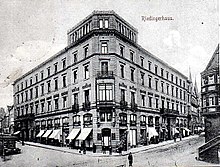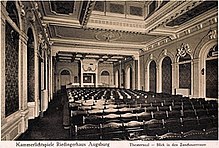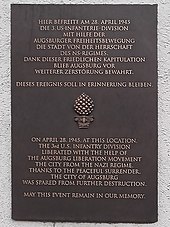Riedingerhaus
The Riedingerhaus was a city palace-like neo-renaissance building in downtown Augsburg . It originally served the entrepreneur Ludwig August Riedinger and his family as a representative residence and was later used as the administrative center of the Augsburg municipal utility . At the end of February 1944, the building was seriously damaged by several bombs during the air raids on Augsburg . In the post-war period, the ruin was finally completely demolished.
history
In 1862 Ludwig August Riedinger acquired the Imhofhaus (Litera D 83) at the Karolinenstrasse / Obstmarkt intersection, which had existed since the Middle Ages, and ordered it to be demolished shortly afterwards. The drafts for the representative new building, the construction of which lasted from 1863 to 1865, came from the Munich architect Gottfried von Neureuther .
Part of the splendidly designed residential and commercial building was also a large ballroom, which was initially used for private theater and concert performances. Between 1912 and 1913, it was converted into a movie theater called Kammerlichtspiele , which was in operation until 1941 and offered space for around 380 visitors. In 1921 (other sources cite the year 1928) the city of Augsburg bought the Riedingerhaus and in 1938 set up the administrative headquarters of the Augsburg public utilities, which was founded in the same year. After the beginning of the Second World War, the fountain in the inner courtyard was removed and the so-called Riedingerbunker was built there. It was supposed to serve as a bomb-proof command center for the city leadership. The fountain figures were brought to the Stadtwerke workshops further outside the city center.
The Riedingerhaus was almost completely destroyed by incendiary and high-explosive bombs during the air raids on the night of February 25th to 26th, 1944. Only the bunker was still fully functional and could continue to be used by Lord Mayor Josef Mayr , City Commander Major General Franz Fehn and their staff as a command center.
On the night of April 27-28, 1945, the Augsburg Freedom Movement came into contact with the advancing US Army and made them aware of the command center in the Riedingerbunker. Lord Mayor Mayr also notified the advancing troops by telephone that the city would be surrendered without a fight. A little later, a company of the US Army made its way to the Riedingerbunker, arrested those present there and thus ended the Nazi rule in Augsburg without fighting. A plaque on the administration building of the Stadtwerke commemorates the peaceful liberation of the city.
The remains of the Riedingerhaus were completely laid down in the post-war period and the rubble was then removed. The last time the bunker in the former atrium was dismantled in 1948. From 1953 to 1955, the new administrative center of the municipal utilities was finally built according to the drafts of the city building councilor Walther Schmidt . The controversial new building was designed in such a way that (in contrast to the previously existing Riedingerhaus) a continuous line of sight from the Rathausplatz to the cathedral could be made possible.
architecture
The corner building made of granite and sandstone, in the Italian neo-renaissance style, had four upper floors with a corner structure above. Similar to the previously existing Imhofhaus, the shape of the Riedingerhaus also formed a visual termination point of the north-south axis of the imperial city and at the same time separated (similar to the former Schwalbenecktor ) the episcopal city in the north from the township in the south.
Inside there was a glass-covered inner courtyard with surrounding arcades and a centrally arranged fountain made of red marble. The fountain was crowned in 1876 by a Germania figure from the royal ore foundry in Munich . Four smaller animal figures were arranged below the Germania figure.
literature
- Günther Grünsteudel et al. (Ed.): Augsburger Stadtlexikon . 2nd Edition. Perlach-Verlag, 1998, ISBN 3-922769-28-4 , p. 754 .
- Astrid Kritter: Augsburg in early photographs 1860–1914 . Schirmer / Mosel Verlag, 1979, ISBN 3-921375-38-X , p. 122-123 .
- Winfried Nerdinger (Ed.): Buildings remember . Dietrich Reimer Verlag, 2012, ISBN 978-3-496-01473-7 , p. 34-35 .
- Winfried Nerdinger (Hrsg.): Augsburgs way to the modern city 1907-1972 . Dietrich Reimer Verlag, 2001, ISBN 3-496-01251-X , p. 59-60 .
Web links
References and comments
- ^ Norbert Lieb and Ludwig Ohlenrot: War damage plan 1944.
- ↑ Franz Häußler: memorial plaques tell Augsburg history . context verlag, Augsburg 2014, ISBN 978-3-939645-73-3 , p. 141.
- ^ Franz Schreiber: On the history of the Augsburg film theater 1896–1950. In: eyes look. (= Series of publications of the museums of the Swabian district ). 1995, pp. 33-37.
- ↑ Note: The fountain figures have been in the State Textile and Industry Museum since 2010 .
- ^ Stadtwerke Augsburg Energie GmbH: District heating for Augsburg . Context Verlag Augsburg, 2014, ISBN 978-3-939645-79-5 , p. 24.
- ↑ A crown for "Germania" . In: Augsburger Allgemeine . January 8, 2010, accessed December 22, 2017.
Coordinates: 48 ° 22 ′ 15.9 ″ N , 10 ° 53 ′ 51.2 ″ E



